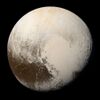Astronomy:2014 OE394
| Discovery | |
|---|---|
| Discovered by | Pan-STARRS (F51) |
| Discovery site | F51, Haleakala Observatory |
| Discovery date | 28 July 2014 |
| Designations | |
| Minor planet category | Classical Kuiper belt object[1][2] |
| Orbital characteristics[3] | |
| Epoch 31 July 2016 (JD 2457600.5) | |
| Uncertainty parameter 2 | |
| Observation arc | 1452 days (5 oppositions) |
| |{{{apsis}}}|helion}} | 51.976 AU |
| |{{{apsis}}}|helion}} | 40.805 ± 0.002 AU |
| 46.391 AU | |
| Eccentricity | 0.12040 ± 0.00005 |
| Orbital period | 316 years |
| Mean anomaly | 70.25469° |
| Inclination | 3.93206 ± 0.00008° |
| Longitude of ascending node | 308.87986 ± 0.0004° |
| 259.35897 ± 0.008° | |
| Physical characteristics | |
| Dimensions | 280-540 km[3] 240-730 km[4] |
2014 OE394 is a large cubewano in the Kuiper belt that was discovered in July 2014 by the Pan-STARRS-1 telescope, and announced on 17 July 2016.[5] It is one of the brighter trans-Neptunian objects, being the 34th brightest cubewano as of 23 July 2016. Its exact size is unknown, but is most likely between 240 and 730 kilometers across.[4] Mike Brown's website lists it as a "possible" dwarf planet, with an estimated diameter of 337 kilometers.[2]
2014 OE394 is also somewhat close to the New Horizons probe, about 8.7 AU away on 1 January 2017, and 7.5 AU on 1 January 2019. Considering its large size, it would make a possible imaging target, as 15810 Arawn was in early 2016. However, as 2014 OE394 is currently over 10 times further than the other was, it would have much lower-precision data.
References
- ↑ Marc W. Buie. "Orbit Fit and Astrometric record for 14OE394". SwRI (Space Science Department). http://www.boulder.swri.edu/~buie/kbo/astrom/14OE394.html. Retrieved 2018-02-17.
- ↑ 2.0 2.1 Brown, Mike. "How many dwarf planets are there in the outer solar system? (updates daily)". http://web.gps.caltech.edu/~mbrown/dps.html. Retrieved 24 July 2016.
- ↑ 3.0 3.1 "IAU Minor Planet Center - 2014 OE394". International Astronomical Union. http://www.minorplanetcenter.net/db_search/show_object?object_id=2014+OE394. Retrieved 24 July 2016.
- ↑ 4.0 4.1 "JPL Small-Body Database Browser". NASA. http://ssd.jpl.nasa.gov/sbdb.cgi?sstr=2014OE394. Retrieved 24 July 2016.
- ↑ "MPEC 2016-O95 : 2014 OE394". International Astronomical Union. http://www.minorplanetcenter.net/mpec/K16/K16O95.html. Retrieved 24 July 2016.
External links



